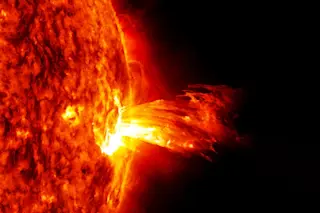Galaxies are large, but many of them—including the Milky Way—are much larger than suspected.
Astronomers at the Keck Observatory in Hawaii have found that the Andromeda galaxy—our closest galactic neighbor, 2.2 million light-years away
Keeping Up With The Joneses
Courtesy Robert Gendler
Our closest neighbor, The Andromeda galaxy, also known as M31, is visible to the naked eye. This image is a mosiaic of 20 frames taken with small telescope.
and a familiar sight in the evening sky—is three times bigger than previously thought. Spectrographic analysis shows that 3,000 stars, once believed to be separate from Andromeda, move in lockstep with the galaxy’s rotation, as part of its outer disk. “It was completely unexpected,” says Caltech astrophysicist Scott Chapman, who made the discovery with Rodrigo Ibata of the Astronomical Observatory in Strasbourg, France.
In a related finding, new images from the Gemini South telescope in Chile exposed another giant disk ...














